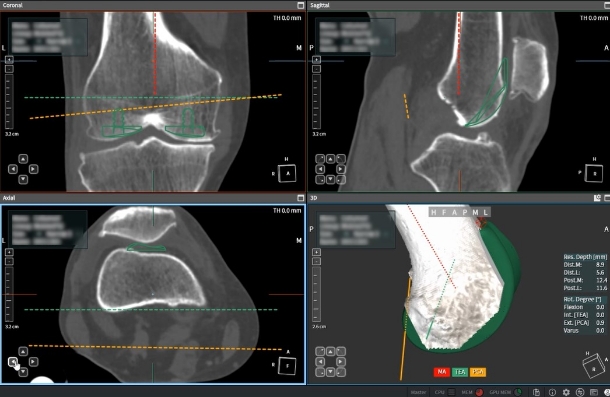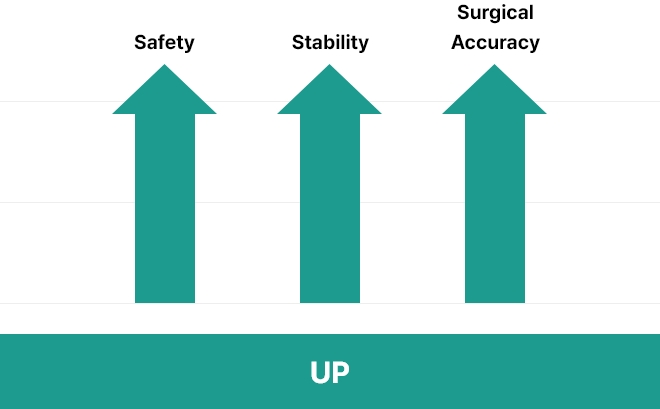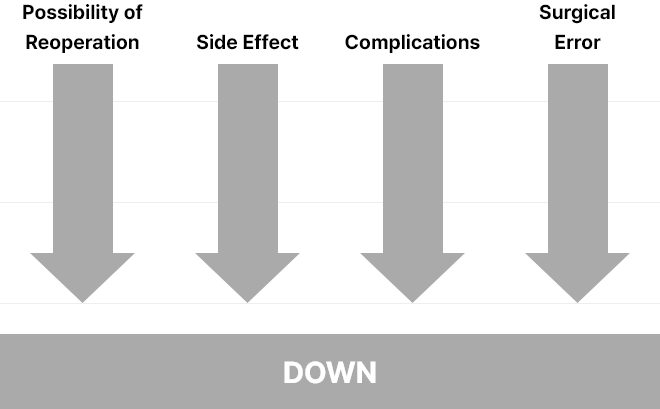CUVIS-joint
is a cutting-edge surgical robot system that improves the completion of artificial joint surgery with optimal surgical planning and precise cutting.
With optimal tracking sensors and self-developed surgical planning CUVIS-joint helps patients that are in need of artificial knee surgery.
Why CUVIS-joint is good?
-

Point. 01
Personalized pre-planning
As each person has a different face, the shape of bone is also different. CUREXO’s artificial joint surgical robot shows the patient’s bone in 3D images, and the doctor can use those images for pre-planning of surgery personalized for the patient.
-

Point. 02
Pre-selection of artificial joint and precise insertion of artificial joint
What’s as important as the precise surgical plan is to select and insert the personalized artificial joint. The doctor uses the robot to select the artificial joint for the patient and insert it accurately.
References
Qualitatssteigerung in der praoperativen Ptanung und intraoperativen Umsetzung durch die Verwervdung von compuierassistierten Systemen and Operationsroboterneine experimentelle Untersuchung 외
-
Point. 03
Precise cutting for submillimeter dimensional accuracy and optimum alignment
Precise cutting serves the optimum result.
CUREXO’s robotic artificial joint surgery system provides the correct alignment of a patient’s leg axis with the submillimeter dimensional accuracy and precise cutting for the optimal surgical outcome.References
Hananouchi T, Sugano N, Nishii T, Nakamura N, Miki H, Kakimoto A, Yamamura M, Yoshikawa H. Effect of robotic milling on periprosthetic bone remodeling. Journal of Orthopaedic Research. 25(8): 1062-1069, 2007. Robot Assisted Hip Replacement / Effectiveness of the ROBODOC system in preventing intraoperative pulmonary embolism 외
-

Point. 04
Reduction of side effect and reoperation
CUREXO’s robotic artificial joint surgery reduces such side effects as inequality of limb length, pulmonary embolism, and fracture. The risk of infection is also reduced by using fewer instruments than in conventional surgery.
References
Nakamura N, Sugano N, Nishii T, Kakimoto A, Miki H. A comparison between robotic-assisted and manual implantation of cementless total hip arthroplasty. Clinical Orthopaedics and Related Research. 468:1072-1081, 2010.
Clinical Result
According to the long-term research on the relocation of hip joint (hip bone), the insertion of more precise artificial joint (implant) provides the appropriate weight load, thus stimulating*1 the bone growth and decreasing the loss of bone density*2.
Artificial joint-bone surface contact ratio 95%*3
Artificial joint-bone surface contact ratio 21%*3
Femoral fracture during surgery 0/75*4
Artificial joint-bone surface contact ratio 21%*4
Inequality of lower limb 0-12mm*4
Inequality of lower limb 0-29mm*4
References
- *1Engh, C.A., Bobyn, J.D., & Glassman, A.H. (1987) Porous-coated hip replacement. The factors governing bone ingrowth, stress shielding, and clinical results. Journal of Bone & Joint Surgery, 69(1), 45-55.
- *2Hanaouchi, T., Sugano, N., Nishi, T., Nakamura, N., Miki, H., Kakimoto, A., Koshikawa, H. (2007) Effect of robotic milling on periprosthetic bone remodeling. Journal of Orthopaedic Research, 25(8), 1062-1069.
- *3Nakamura, N., Sugano, N., Nishii, T., Kakimoto, A., & Miki, H. (2010) A comparison between robotic-assisted and manual implantation of cementless total hip arthroplasty. Clinical Orthopaedics and Related Research, 486, 1072-1081.
- *4Paul, H., Bargar, W., Mittlestadt, B., Musits, B., Taylor, R., Kazanzides, P., Hanson, W. (1992) Development of a Surgical Robot for Cementless Total Hip Arthroplasty. Clinical Orthopaedics and Related Research, 25, 57-66.
* These products are medical robots. Please check the caution and instructions before use.











